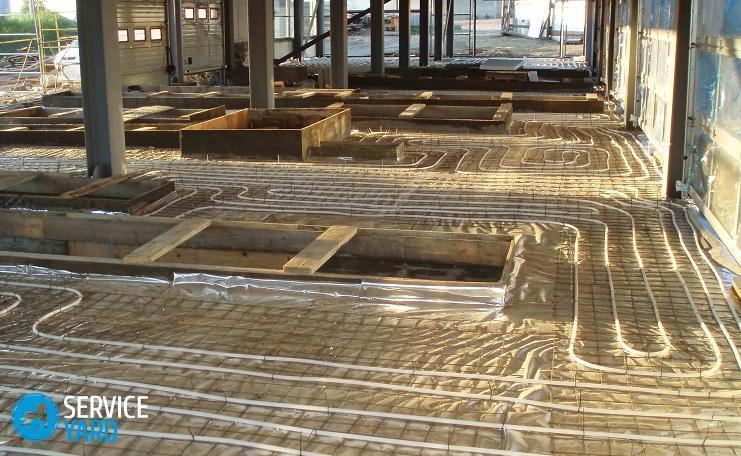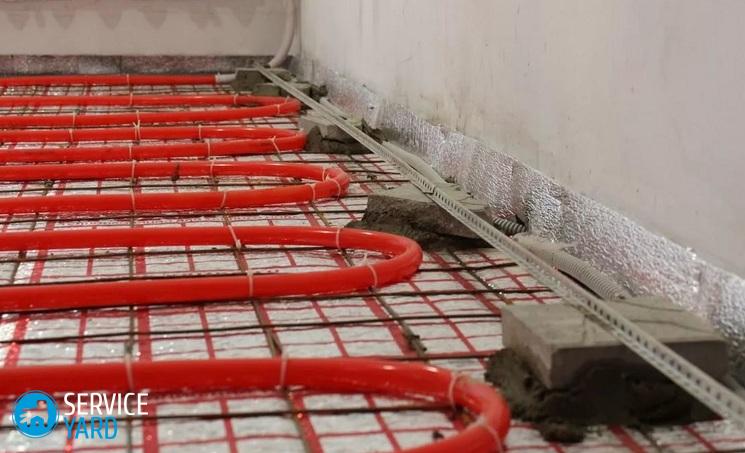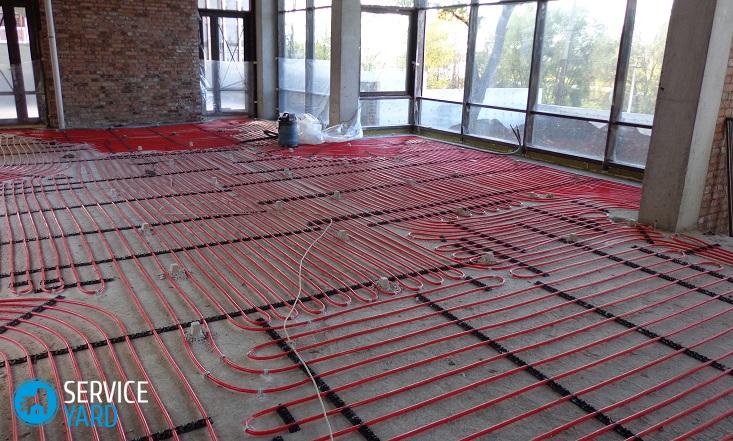Heated floor from central heating in the apartment

Central heating is wonderful, but sometimes the heating systems in the houses are designed so that the floor remains cold anyway. It can be heated. How? For example, having built a warm floor from the central heating in the apartment - with your own hands or with the involvement of specialists from the communal service. You can find out how to do this from the article.
to contents ↑Water or electric?
Even before you make a warm floor in the apartment, you need to solve one important question: what will be the main function of your system? Warm floor can be:
- main source of heat;
- additional heater.
Based on this, you can choose which system of lower heating is more suitable for you:
- water;
- electric;
- infrared.
Important! If you plan to completely replace the central heating batteries, you can consider the possibility of installing a water heated floor. Sometimes an electric floor can become the main heating system in a house, but much more often it is used as a means of additional heating.
Electrical systems are also different - in the catalogs you can see:
- cable floors;
- heating mats.
Important! Many prefer infrared heaters. They are also powered from the mains, but it is customary to separate them into a separate class, because they use a special type of heating elements.
Each option has its own advantages and disadvantages.
to contents ↑Water floor benefits
Trying to figure out how to make a warm floor from heating in an apartment, think about whether you really need it. It has a lot of advantages:
- such a system makes it possible to evenly distribute heat throughout the apartment, this is especially important if there are small children in the house who like to play on the floor;
- at its core, a warm floor is the same pipes, only laid horizontally, so your apartment will receive as much heat as before;
- batteries can be completely removed - and this moment is always of interest to those who seek to create an original interior;
- such a floor can serve for a very long time, if it is correctly laid and made of quality materials.
What is bad water floor heating?
Does the underfloor underfloor heating in the apartment have any flaws? Alas, there are cons:
- Not every room can equip such a system.
- In any case, you will have to consult with the municipal service, or even get approval from the local administration.
- If all the work is done according to the rules, the pleasure is quite expensive.
- During installation, it is necessary to comply with technological requirements, which not every owner can do.
- No one is safe from leaks, and if they arise, you will have to make a thorough repair of the entire structure, including replacing the topcoat and concrete screed.
- If you don’t notice the leak in time, serious troubles may arise with your neighbors.
- Neighbors may also have questions if the installation of a water floor in your apartment has made their homes colder.
Of course, many disadvantages automatically disappear if you arrange underfloor heating in an apartment with individual heating. But the best option is to do such floors in a private house with your own boiler, where there are no neighbors whose interests may be violated, nor the need to coordinate anything with the authorities.
to contents ↑Get permission
So, the possible costs do not scare you and you still dream of laying a warm floor for heating in the apartment? Well, you have to start with a visit to the utility company serving your home. Find her work is not difficult - the address and phone numbers are written in the receipt for payment of utilities.
Important! It is necessary to apply there in order to avoid large fines for illegal tapping. And in the worst case, the offender is waiting for a trial, the result of which, most likely, will be a demand to return everything to its original state. At the expense of the intruder, of course.
Obtaining permission is not always possible. Heating systems in high-rise buildings are calculated so that the margin of safety is very small. If you are ahead of your neighbors and the first to decide to install a warm water floor - maybe you are lucky. Whether they allow you or not depends on many factors:
- type of heating system in the house - when there are two risers, direct and reverse, they can give permission, but if one does not;
- temperature regime - your insert will inevitably affect the temperature in neighboring apartments, so that your innovation will only be agreed if the coolant has an extremely high temperature;
- places where the heat exchanger is located - above or below, if it is above - residents of lower floors are more likely to get permission, and vice versa.
Almost everything depends on the type of wiring in the house. It happens:
- vertical
- horizontal.
In the first case, obtaining permission is most likely not possible. But with horizontal wiring, coordination becomes quite real. So the answer to the question of whether it is possible to make a warm floor from central heating in an apartment is not as simple as it seems.
to contents ↑Important! Usually permission is given if you completely remove the radiators - that is, you practically change the vertical heating system to horizontal, and the temperature of the coolant and the power of the entire system in the house remain the same. If your application was refused, stop your choice on other systems.
Make a project
You should not contact the management company if you don’t have a good idea of what you want. Therefore, first you still need to make at least a rough draft:
- Draw a plan for your apartment.
- Put the pipes you intend to lay on it.
- Specify the type of connection.
- Specify the materials that you intend to use for screed, waterproofing and other work.
Even with such a primitive plan, talking with a technician will be much easier. At the same time, it will help to correct your idea if some materials are not strong enough, while others cannot be used at all in residential premises.
to contents ↑Important! If you are going to make a warm water floor with your own hands, think carefully - should pipes everywhere lie? Some areas do not need to be warmed up. For example, under the cabinets the floor does not need to be heated, and under the refrigerator it is even harmful.
Determined with the connection
If you still decide to overcome all the obstacles and already almost know how to make a water floor heating in the apartment, you need to determine the type of connection. There are only two of them for a city apartment in an ordinary high-rise building:
- through a heated towel rail;
- directly to the heating system.
The most popular way to connect to a heat source is through a heated towel rail. It is fed back, that is, a coolant that has already managed to partially fulfill its functions. The temperature will be quite acceptable - no more than 50 ° C, and more often a little less, about 35-40 ° C. If you have already installed shut-off valves, the situation is greatly simplified.
to contents ↑Important! The biggest drawback of connecting to a central heating system is too high a temperature. The coolant is supplied through a heat exchanger, its temperature is about 70 ° C, so that even a lover of tropical heat will not feel very comfortable in such an apartment. If you still decide on such a step, you have to put a collector group.
We make calculations
The next step after obtaining permission and determining the type of connection is calculations:
- Calculate the total power that will be provided for additional heating (if the floor is the main source of heat, the power does not change).
- Consider heat loss.
- Remember to also consider the type of radiator.
- Find out the power of the circulation pump.
- Calculate how much you have to raise the base.
The calculations are quite complicated, not every owner will cope with such a task. Therefore, it makes sense to contact the same communal service or a certified design organization.
to contents ↑Important! Underfloor heating in combination with suspended ceilings can significantly reduce your living space, so it’s best to do everything in accordance with the norms of SNiP.
Classics of the genre - connection to the heating system
In order to connect a warm floor according to the classical scheme, you need a lot:
- circulation pump;
- distribution unit;
- collector group;
- temperature sensors.
Distribution unit
The most important part is the distribution node. He is responsible for the temperature of the water in the system. Water needs to be cooled to an acceptable temperature, that is, up to 30-35 ° C, otherwise the system will not last long.
Important! The diameter of the pipes is 12-20 mm.
Three-way valve
The main part of the distribution system is a three-way valve, on which the temperature distribution depends. He has a sensor - a thermal head. Temperature is controlled by changing the position of the stem. It works like this:
- The temperature of the coolant rises above the set temperature.
- The damper closes the flow - sometimes completely, sometimes partially.
Important! In apartments on the middle floors, a two-way valve is usually used.
Circulation pump
Without this detail, the system will not work at all, because water flows where there is no resistance. You need to direct it to specific pipes, but without forced circulation this cannot be done. It is placed after the distribution unit, but in front of the collector group. The water supply process is as follows:
- The thermal head delivers cooled water to the pump.
- The coolant is sent to the collector group.
- The fluid is distributed through the pipes.
Collector group
This is also an important node, which necessarily includes:
- drainage tap;
- air outlet.
At the top is an air outlet, at the bottom is a tap.
Mud filters
To extend the life of your underfloor heating system, you need to install filters. The fact is that water in heating systems is not of high quality. She, of course, is cleaned, but not to drinking quality. Dirt tends to clog pipes, which can lead to very serious troubles. Therefore, the particles must be filtered.
to contents ↑If you live in your own home
It will be much easier for happy owners of individual houses to deal with a warm floor. There are two main options:
- Connect the warm floor to the hot water system.
- Put the boiler, and fill the pipes with antifreeze.
We mount a heat-insulated floor
All approvals are passed, the plan is developed and the calculations are made. It's time to get down to business, that is, to installation. First you need to tidy the apartment:
- completely close the heat circuit;
- to glaze the balcony;
- replace frames;
- insulate the walls.
After that, you can begin to engage in sex. For specialists, the styling scheme is called a pie, which consists of several layers:
- waterproofing;
- insulation;
- reflective foil;
- pipes;
- screeds;
- topcoat;
- baseboard.
Waterproofing
The floor must be well insulated. This is necessary not only to avoid trouble with neighbors, but also for the safety of your apartment. As they say, water sharpens a stone, and even the weakest leak will eventually lead to the destruction of the entire system. Therefore, possible damage must be minimized.
Heater and reflector
It may be sheet, but now many people use special mats designed specifically for underfloor heating. Thickness depends on where the apartment is located. For example, if there are unheated rooms below, it is better to make the layer thicker. Foil is used as a reflector. Without it, part of the heat will certainly go down.
Which pipes to take?
The ideal material for a warm floor is metal. Heat losses are minimal - it is not susceptible to corrosion and lasts long enough. As a rule, a pipe with a diameter of 1.5-1.6 cm is taken - this is the most popular option, but others are also found.
Screed
A concrete screed is laid on top of the pipes, especially when the insulation is made of sheet materials. But you have to be careful. The screed is made of concrete - it has a lot of weight, so it is very important to make the correct calculations, otherwise - the entire contents of your apartment, along with the warm floor, may fall to the neighbors or the basement.
Important! The use of profile mats allows you to do without screeds, which is why apartment owners often prefer them.
Finish finish
The last layer is the finish floor, that is, the coating that you lay in the rooms. There is one subtlety. If you use tiles or roll materials, you cannot lay them directly on the screed. Therefore, first the base is made of plywood sheets, and already on it - the finish coating. And the laminate can be laid directly on the profile mats.
Pipe Laying Schemes
How to lay pipes? There are few options, just two:
- the snake;
- spiral.
It is not at all necessary that all the pipes in the room will be laid only in zigzags or only in a spiral - you can also come up with combinations of these figures. For example, laying with a snake allows you to adjust the temperature so that the area near the outer wall warms up better.
And how many pipes can you put? It’s also an important question. There are certain standards on this score - the total length of the circuit should not be more than 100 m. That is, in the case when you are making underfloor heating throughout the apartment, it is better to arrange a separate circuit in each room. If we talk about the distance between the turns, then it is calculated based on the temperature that you need. The closer the turns to each other, the warmer. The standard distance is 15-30 cm.
to contents ↑Stock footage
Thus, the installation of a heated floor in an apartment is quite possible. However, the best option is to connect it to the boiler, sometimes it is also possible in multi-storey buildings. Regardless of which option you choose, special attention should be paid to the quality of the materials and precise adherence to the technology.
- How to choose a vacuum cleaner taking into account the characteristics of the house and coatings?
- What to look for when choosing a water delivery
- How to quickly create comfort at home - tips for housewives
- How to choose the perfect TV - useful tips
- What to look for when choosing blinds
- What should be running shoes?
- What useful things can you buy in a hardware store
- Iphone 11 pro max review
- Than iPhone is better than Android smartphones






